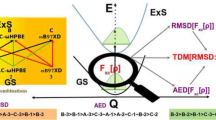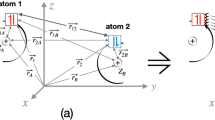Abstract
A practical mixed basis set was developed to facilitate accurate calculations of potential energy surfaces for π-stacking interactions. Correlation consistent basis sets (cc-PVXZ) were augmented by p-type Gaussian functions placed above and below the planes of C6 moieties. Møller-Plesset (MP2, SCS-MP2) and coupled cluster [CCSD(T)] calculations show that such generated basis sets provide an accurate description of π-stacking systems with favorable computation times compared to the standard augmented basis sets. The addition of these off-center functions eliminates the linear dependence of the augmented basis sets, which is one of the most encountered numerical problems during calculation of the oligomers of polyaromatic hydrocarbons (PAH). In this work, we present a comparative study of the general characteristics of the potential energy surfaces for the parallel stacked and T-shape conformations of benzene and planar C6 clusters, using a combination of cc-PVXZ and our optimized functions. We discuss properties, such as the depth and curvature of the potential functions, short and long distance behavior, and the frictional forces between two model monomers.

Frictional forces for C6 (δx in Ångstroms and F is in kcal/mol Å−1)





Similar content being viewed by others
References
Buckingham AD, Del Bene JE, McDowell SAC (2008) The hydrogen bond. Chem Phys Lett 463(1–3):1–10
Hobza P, Sponer J (1999) Structure, energetics, and dynamics of the nucleic acid base pairs: nonempirical ab initio calculations. Chem Rev 99(11):3247–3276
Ditzler MA, Otyepka M, Sponer J, Walter NG (2010) Molecular dynamics and quantum mechanics of RNA: conformational and chemical change we can believe in. Acc Chem Res 43(1):40–47
Asensio JL, Arda A, Canada FJ, Jimenez-Barbero J (2013) Carbohydrate–aromatic interactions. Acc Chem Res 46(4):946–954
Yılgör E, Yılgör İ, Yurtsever E (2003) Hydrogen bonding and polyurethane morphology.I. Quantum mechanical calculations of hydrogen bond energies and vibrational spectroscopy of model compounds. Polymer 43(24):6551–6559
Irudayam SJ, Henchman RH (2012) Long-range hydrogen bond structure in aqueous solutions and water-vapor interface. J Chem Phys 137(3):034508
Hobza P (2008) Stacking interactions. Phys Chem Chem Phys 10(19):2581–2583
Pumera M, Wong CHA (2013) Graphane and hydrogenated graphene. Chem Soc Rev 42(14):5987–5995
Müller-Dethlefs K, Hobza P (2000) Noncovalent interactions: a challenge for experiment and theory. Chem Rev 100(1):143–167
Riley KE, Pitonak M, Jurecka P, Hobza P (2010) Stabilization and structure calculations for noncovalent interactions in extended molecular systems based on wave function and density functional theories. Chem Rev 110(9):5023–5063
Zhao Y, Truhlar D (2008) The M06 suite of density functionals for main group thermochemistry, thermochemical kinetics, noncovalent interactions, excited states, and transition elements: two new functionals and systematic testing of four M06-class functionals and 12 other functionals. Theor Chem Accounts 120(1–3):215–241
Aquino AJA, Nachtigallova D, Hobza P, Truhlar DG, Hattig C, Lischka H (2011) The charge-transfer states in stacked nucleobase dimer complex: a benchmark study. J Comput Chem 32(7):1217–1227
Jansen G, Hesselmann A (2001) Comment on “Using Kohn–Sham orbitals in symmetry-adapted perturbation theory to investigate intermolecular interactions”. J Phys Chem A 105(49):11156–11157
Grimme S, Antony J, Ehrlich S, Krieg H (2010) A consistent and accurate ab initio parametrization of density functional dispersion correction (DFT-D) for the 94 elements H-Pu. J Chem Phys 132(15):154104
Grimme S (2003) Improved second-order Møller-Plesset perturbation theory by separate scaling of parallel- and antiparallel-spin pair correlation energies. J Chem Phys 118(20):9095–9102
Yurtsever E (2010) Stacking of triphenylene: characterization of the potential energy surface. Theor Chem Accounts 127(3):133–139
Frost AA (1967) Floating spherical Gaussian orbital model of molecular structure. I. Computational procedure. LiH as an example. J Chem Phys 47(10):3707–3713
Brailsford DF, Hall GG, Hemming N, Martin D (1975) Floating s and p-type gaussian orbitals. Chem Phys Lett 35(4):437–440
Williams HL, Mas EM, Szalewicz K, Jeziorski B (1995) On the effectiveness of monomer-centered, dimer-centered, and bond-centered basis funstions in calculations of intermolecular interactions. J Chem Phys 103(17):7374–7391
Ding Y, Mei Y, Zhang JZH, Tao FM (2008) Efficient bond function basis sets for pi–pi interaction energies. J Comput Chem 29(2):275–279
Li P (2012) DFT studies on configurations, stabilities, and IR spectra of neutral carbon clusters. J At Mol Sci 3(4):308–322
Werner HJ, Knowles PJ, Knizia G, Manby F, Schultz M (2010). MOLPRO, version 2010.1, a package of ab initio programs.
Boys SF, Bernardi F (1970) The calculation of small molecular interactions by the differences of separate total energies. Some procedures with reduced errors. Mol Phys 19(4):553–566
Janowski T, Pulay P (2007) High accuracy bencmark calculations on the benzene dimer potential energy surface. Chem Phys Lett 447:27–32
Sherrill CD, Sumpter BG, Sinnkrot MO, Marshall MS, Hohenstein EG, Walker RC, Gould IR (2009) Assessment of standard force field models against high quality an initio potential curves for prototypes of π-π, CH/π, and SH/π interactions. J Comput Chem 30:2187–2193
Author information
Authors and Affiliations
Corresponding author
Rights and permissions
About this article
Cite this article
Yurtsever, E. A mixed basis with off-center Gaussian functions for the calculation of the potential energy surfaces for π-stacking interactions: dimers of benzene and planar C6 . J Mol Model 21, 11 (2015). https://doi.org/10.1007/s00894-014-2558-0
Received:
Accepted:
Published:
DOI: https://doi.org/10.1007/s00894-014-2558-0




